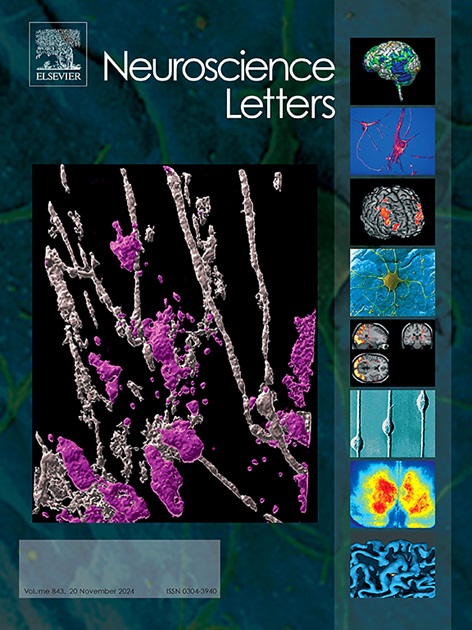Changes in gene expression of D2 and D5 receptors in the thalamus and midbrain caused by a persistent painful stimulus in Parkinsonian rats
IF 2.5
4区 医学
Q3 NEUROSCIENCES
引用次数: 0
Abstract
Pain is the most common and underdiagnosed non-motor symptom in Parkinson’s disease. Dopaminergic receptors D2 and D5 have been implicated in pain modulation. In this study, the expression of D2 and D5 receptors in the midbrain and thalamus in response to a painful stimulus was evaluated. The animals were assigned to a 6-OHDA group, a Sham group and a Control group. 6-OHDA was administered to the experimental group and 2 μl of 1 % ascorbic acid to the Sham group in the substantia nigra pars compacta. The midbrain and thalamus were dissected for RT-qPCR. In the formalin test, phase 1 showed significant differences between the Sham, 6-OHDA and Control groups, while in phase 2 the 6-OHDA group presented a greater nociceptive response. In the cylinder test, the 6-OHDA group showed a reduction in the use of the left limb and both limbs. In the open-field test, the 6-OHDA group spent more time in corners and showed less exploration in the periphery and center. An increasing trend for D5 was observed in the midbrain of the 6-OHDA group and in the thalamus of the Sham group. Dopaminergic injury induced by 6-OHDA as part of the parkinsonian model alters motor function, increases anxiety, and increases nociceptive response in the persistent phase of the formalin model. In addition, a non-significant increase in D5 receptor expression in the midbrain and thalamus may suggest an adaptive response of dopaminergic signaling to persistent pain.
持续疼痛刺激对帕金森大鼠丘脑和中脑D2和D5受体基因表达的影响
疼痛是帕金森病最常见的非运动症状。多巴胺能受体D2和D5参与疼痛调节。在这项研究中,D2和D5受体在中脑和丘脑对疼痛刺激的反应进行了评估。将动物分为6-羟色胺组、假手术组和对照组。实验组给予6-羟色胺,假手术组给予黑质致密部1%抗坏血酸2 μl。解剖中脑和丘脑进行RT-qPCR。在福尔马林测试中,第1阶段Sham组、6-OHDA组和Control组之间存在显著差异,而第2阶段6-OHDA组表现出更大的伤害性反应。在圆柱体试验中,6-OHDA组显示左肢和四肢的使用减少。在空地试验中,6-OHDA组在角落活动的时间较多,在外围和中心活动的时间较少。D5在6-OHDA组中脑和Sham组丘脑呈升高趋势。在福尔马林模型的持续期,6-OHDA诱导的多巴胺能损伤会改变运动功能,增加焦虑,并增加伤害性反应。此外,中脑和丘脑中D5受体表达的不显著增加可能表明多巴胺能信号对持续疼痛的适应性反应。
本文章由计算机程序翻译,如有差异,请以英文原文为准。
求助全文
约1分钟内获得全文
求助全文
来源期刊

Neuroscience Letters
医学-神经科学
CiteScore
5.20
自引率
0.00%
发文量
408
审稿时长
50 days
期刊介绍:
Neuroscience Letters is devoted to the rapid publication of short, high-quality papers of interest to the broad community of neuroscientists. Only papers which will make a significant addition to the literature in the field will be published. Papers in all areas of neuroscience - molecular, cellular, developmental, systems, behavioral and cognitive, as well as computational - will be considered for publication. Submission of laboratory investigations that shed light on disease mechanisms is encouraged. Special Issues, edited by Guest Editors to cover new and rapidly-moving areas, will include invited mini-reviews. Occasional mini-reviews in especially timely areas will be considered for publication, without invitation, outside of Special Issues; these un-solicited mini-reviews can be submitted without invitation but must be of very high quality. Clinical studies will also be published if they provide new information about organization or actions of the nervous system, or provide new insights into the neurobiology of disease. NSL does not publish case reports.
 求助内容:
求助内容: 应助结果提醒方式:
应助结果提醒方式:


